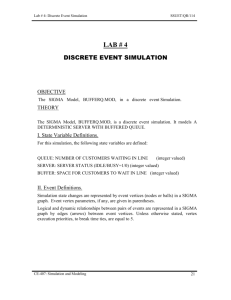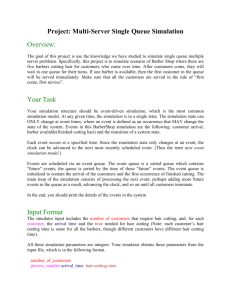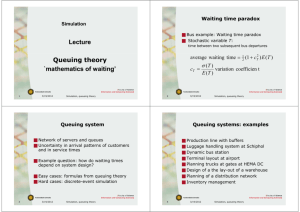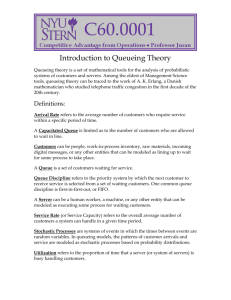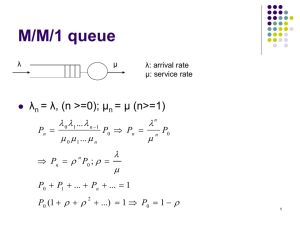Modeling and Analysis using Computational Tools
advertisement
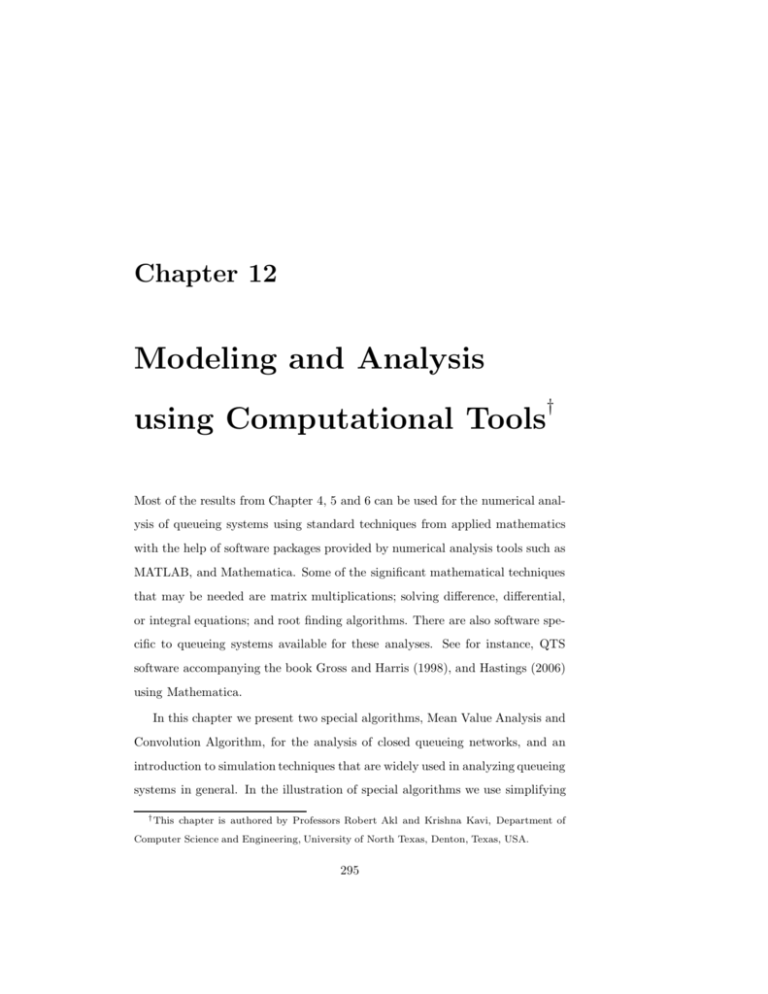
Chapter 12
Modeling and Analysis
using Computational Tools
†
Most of the results from Chapter 4, 5 and 6 can be used for the numerical analysis of queueing systems using standard techniques from applied mathematics
with the help of software packages provided by numerical analysis tools such as
MATLAB, and Mathematica. Some of the significant mathematical techniques
that may be needed are matrix multiplications; solving difference, differential,
or integral equations; and root finding algorithms. There are also software specific to queueing systems available for these analyses. See for instance, QTS
software accompanying the book Gross and Harris (1998), and Hastings (2006)
using Mathematica.
In this chapter we present two special algorithms, Mean Value Analysis and
Convolution Algorithm, for the analysis of closed queueing networks, and an
introduction to simulation techniques that are widely used in analyzing queueing
systems in general. In the illustration of special algorithms we use simplifying
† This
chapter is authored by Professors Robert Akl and Krishna Kavi, Department of
Computer Science and Engineering, University of North Texas, Denton, Texas, USA.
295
296
CHAPTER 12. MODELING AND ANALYSIS
assumptions that also show how they provide practical solutions to systems that
are intractable or when their behaviors cannot be easily modeled using simple
probability distributions.
As a note to the reader, we point out that the notations used in this chapter
are slightly modified from those used in Chapter 7. For instance, since the
service times used are deterministic, no expected values are used in the analysis
and notations representing random variables are used also for the expected
values.
12.1
Mean Value Analysis
The Mean Value Analysis (MVA) applies to closed queueing networks and provides their performance in mean values. Also MVA can be used only if a queueing network has a product form solution. We will limit ourselves to simple
service centers with fixed-limit on the queue size and a single class of customers
(or jobs).
Before we introduce MVA, consider the following network representing a
computer system with a single central processing unit (CPU) and several I/O
devices (or file servers). Each of these devices represents a service station. A
task (or a computer program) starts at the CPU, visits a file server, returns to
12.1. MEAN VALUE ANALYSIS
297
CPU for more service, and repeats this process of visiting a file server and CPU,
until the task is completed. Thus a job makes Vj visits to service station Sj .
If jobs are not lost, the arrival rate at each service station is the same as
the departure rate, the arrival rate into the computer system is the same as
the departure rate from the system. For such systems Vj can be computed as
Vj =
γj
γ0 ,
where γ0 is the arrival rate of jobs entering the system (and also leaving
the system assuming job flow balance) and γj is the arrival rate of jobs at jth
P
service center. The number of visits to CPU is given by 1 + j=M
j=2 Vj .
These formulations are based on “operational laws (Denning and Buzen,
1978) introduced in Chapter 7, and that can be verified by direct observations.
In a closed network, the number of jobs in the system is fixed. This can be
a model for a system where a new job arrives soon after a completed job leaves
the system. Such models are used to represent time-sharing computer systems
where the number of terminals connected to the system represents the total
number of jobs in it. One can insert a delay before a job reenters the system to
represent think-time of a user sitting at a terminal.
It has been shown in Reiser and Lavenberg (1980) that the mean response
time for service at jth service station in a closed network with N jobs is given
by
Rj (N ) = (1/µj ) ∗ [1 + Qj (N − 1)]
(12.1.1)
where µj is the service rate and Qj (N ) is the mean number of jobs at the jth
service station. This relationship is intuitive. The N th job arriving at jth
service center will see a queue with a mean number of jobs (including one being
serviced) given by Qj (N − 1), and must wait for these jobs to be serviced. It
should be noted that this formulation assumes that the service distribution is
exponential. The response time shown in the equation above can be solved
iteratively, by starting with Qj (0) = 0.
In order to compute the mean response time R(N ) of the system with N
298
CHAPTER 12. MODELING AND ANALYSIS
jobs and M service centers, we will use operational laws that specify that
R(N ) =
M
X
Rj (N )Vj
(12.1.2)
j=1
Here Vj is the number visits that a job makes to jth service center.
Using Littles law, we can obtain the mean throughput rate and mean number
of jobs at service station j. In case of a delay representing think time, the system
throughput is given by X(N ) =
N
(R+Z)
where Z is the mean think time of an
user. The queue lengths of each service station can be calculated as
Qj (N ) = X(N ) ∗ Rj ∗ Vj
(12.1.3)
Example 12.1.1
Consider a computer system with a CPU (C) and 3 file servers (labeled F1, F2,
F3) that can perform file read and writes. Let us assume that each job vists
F1 10 times, F2 20 times and F3 30 times. After each visit to a file server, the
job comes back to CPU (thus the number visits each program makes to CPU
is 1+10+20+30 = 61). We are also given the following data. The mean service
times per visit to the various service stations are given as: CPU = 1; F1= 2;
F2= 3; F3 = 4.
Initialization: N = 0
QC = QF 1 = QF 2 = QF 3 = 0
Iteration 1: N = 1
RC (1) = (1/µC )[1 + QC (0)] = 1 ∗ [1 + 0] = 1
RF 1(1) = (1/µF 1 )[1 + QF 1 (0)] = 2 ∗ [1 + 0] = 2
RF 2(1) = (1/µF 2 )[1 + QF 2 (0)] = 3 ∗ [1 + 0] = 3
RF 3(1) = 1/µF 3)[1 + QF 3 (0)] = 4 ∗ [1 + 0] = 4
System Response time
R(1) =
=
RC (1) ∗ VC + RF 1(1) ∗ VF 1 + RF 2(1) ∗ VF 2 + RF 3(1) ∗ VF 3
1 ∗ 61 + 2 ∗ 10 + 3 ∗ 20 + 4 ∗ 30 = 261
12.1. MEAN VALUE ANALYSIS
299
Queue lengths at each service station are computed as follows
Qj (N )
=
[N/R(N )] ∗ Rj(N ) ∗ V j
QC (1)
=
[1/R(1)] ∗ RC (1) ∗ VC = (1/261) ∗ 1 ∗ 61 = 0.234
QF 1 (1)
=
[1/R(1)] ∗ RF 1 (1) ∗ VF 1 = (1/261) ∗ 2 ∗ 10 = 0.077
QF 2 (1)
=
[1/R(1)] ∗ RF 2 (1) ∗ VF 2 = (1/261) ∗ 3 ∗ 20 = 0.230
QF 3 (1)
=
[1/R(1)] ∗ RF 3 (1) ∗ VF 3 = (1/261) ∗ 4 ∗ 30 = 0.460
Iteration 2. N = 2
RC (2)
= (1/µC )[1 + QC (1)] = 1 ∗ [1 + 0.234] = 1.234
RF 1 (2)
= (1/µF 1 )[1 + QF 1 (1)] = 2 ∗ [1 + 0.077] = 2.154
RF 2 (2)
= (1/µF 2 )[1 + QF 2 (1)] = 3 ∗ [1 + 0.230] = 3.69
RF 3 (2)
= (1/µF 3 )[1 + QF 3 (1)] = 4 ∗ [1 + 0.460] = 5.84
System Response time
R(2) =
=
RC (2) ∗ VC + RF 1(2) ∗ VF 1 + RF 2(2) ∗ VF 2 + RF 3(2) ∗ VF 3
1.234 ∗ 61 + 2.154 ∗ 10 + 3.69 ∗ 20 + 5.84 ∗ 30 = 345.814
Queue lengths
QC (2)
=
[2/R(2)] ∗ RC (2) ∗ VC = (2/345.814) ∗ 1.234 ∗ 61 = 0.435
QF 1 (2)
=
[2/R(2)] ∗ RF 1 (2) ∗ VF 1 = (2/345.814) ∗ 2.154 ∗ 10 = 0.125
QF 2 (2)
=
[2/R(2)] ∗ RF 2 (2) ∗ VF 2 = (2/345.814) ∗ 3.69 ∗ 20 = 0.427
QF 3 (2)
=
[2/R(2)] ∗ RF 3 (2) ∗ VF 3 = (2/345.814) ∗ 5.84 ∗ 30 = 1.013
And we can continue the iterative process to find response times and queue
lengths for higher number of jobs, N in the system. The table below shows
some values.
300
CHAPTER 12. MODELING AND ANALYSIS
N
R
QC
QF 1
QF 2
QF 3
1
261.000
0.234
0.077
0.230
0.460
2
345.814
0.435
0.125
0.427
1.013
3
437.215
0.601
0.154
0.587
1.657
4
534.875
0.730
0.173
0.712
2.385
5
637.915
0.827
0.184
0.805
3.184
6
745.494
0.897
0.191
0.872
4.041
7
856.711
0.946
0.195
0.918
4.942
8
970.700
0.978
0.197
0.948
5.877
9
1086.709
0.999
0.198
0.968
6.834
10
1204.129
1.013
0.199
0.981
7.807
20
1322.500
1.857
0.363
1.797
15.983
30
2407.349
2.172
0.340
2.092
25.397
40
3573.418
2.166
0.300
2.076
35.458
50
4778.653
2.021
0.272
1.931
45.776
100
5998.709
3.072
0.424
2.932
93.572
The following pseudo algorithm using C programming notation can be used
for MVA.
for (j=1; i <= M; j++) //Initialization
Q[j] = 0.0;
for (k=1; k <= N; k++) // Main loop
{
for (j=1; j <= M; j++) //Compute new response times
R[j] = (1.0 / mu[j]) * (Q[j] + 1.0);
R = 0.0;
for (j=1; j <= M; j++) //Compute system response time
R = R + R[j];
for (j=1; j <= M; j++) //Update queue lengths
Q[j] = (k/R)*R[j];
}
When dealing with networks containing delay centers, where a job arriving
at a center is serviced immediately without having to wait, the only change that
needs to be made to MVA is the response time computation. For delay centers
12.2. CONVOLUTION ALGORITHM
301
we use Rj (N ) = 1/µj .
Mean Value Analysis can be used for multiple classes of customers. In this
case, we iterate the MVA analysis for each class of customers. In other words,
we find the average queue lengths iteratively for each customer class.
There have been many extensions and approximate solutions proposed with
MVA so that MVA can be used with other types of queues, to obtain upper
bounds on response times, or to improve the computational efficiency of the
analyses. It is beyond the scope of this book to discuss these extensions.
12.2
Convolution Algorithm
The MVA presented so far provides an easy way to obtain average (mean)
response times and queue lengths, but MVA is not useful for obtaining more
detailed analysis, such as the distribution of queue lengths or response times.
In this section we will introduce how some of these analyses can be made using
convolution techniques.
Chapter 7 included an analysis of both closed and open networks of queues.
These analyses can be used to solve for the distribution of jobs in a system,
P (n1, n2, . . . , nM ), where there are nj jobs at service station j (including the
job being serviced). [n1, n2, . . . , nM ] denotes the state of the system. Note that
the system state represents an element of the set defined here as
→
N−
= {[n1, n2, . . . , nm ]|
j=M
X
nj = N |}
j=1
In this chapter we will restrict ourselves to closed networks of queues, and
provide a technique that can be implemented as a computer program.
For systems where the service time per job is independent of the queue
lengths (load-independent service), we can use the following result (Gordon and
Newel 1967)
P (n1 , n2, . . ., nM ) =
nM
1 n2
dn
1 d2 . . . dM
G(N )
(12.2.1)
302
CHAPTER 12. MODELING AND ANALYSIS
where dj is the total service demand per job at the jth device and N =
Pj=m
j=1
nj .
The total demand for service by a job at a service station is the combined
service requirements for all visits a job makes to the service station. G(N ) is a
normalizing constant such that the probabilities that the system is in any one
of the possible states add to 1. This is very complex since we need to find the
probabilities for all possible states of the system where the number of states is
given by
N +M −1
M −1
with N as the number of jobs in the system and M as the number of service
stations.
Buzens (1973) iterative solution method for G(N ), described in Chapter 7,
is based on the following observation.
M
XY
−
→
N
(dj )
nj
=
X
M
Y
−
→
N |nM =0 j=1
j=1
(dj )
nj
+
X
M
Y
(dj )nj
−
→
j=1
N |nm >0
(12.2.2)
where the summation is over the set of all possible states [n1, n2, . . . , nM ], such
PM
that j=1 nj = N . The first term on the right hand side is the case when there
are zero customers at service station M , which can be viewed as a system with
one less service station. The second term indicates that there is at least one
customer at service station M , and places one service demand on that server.
Thus the second term can be rewritten as where the summation is over the set
P
of all possible vectors [n1, n2, . . . , nM ], such that M
j=1 nj = N − 1. Note that
since there is at least one customer at service station M, we factored dM out.
The summation now deals with a system with one less customer. Thus we have
M
XY
−
→
N
(dj )nj =
j=1
If we use g(n, m) for
given by g(N, M ).
X
M
Y
(dj )nj + dM
−
→
N |nM =0 j=1
M
X Y
(dj )nj
−−−→ j=1
N −1
(12.2.3)
P Qm
nj
→
−
n j=1 (dj ) then the normalizing constant G(N ) is
12.2. CONVOLUTION ALGORITHM
303
But as we have seen
g(n, m) = g(n, m − 1) + dm ∗ g(n − 1, m)
(12.2.4)
The initial conditions are:
g(j, 0)
=
0 for
j = 1, 2, . . ., n
g(0, k) =
1 for
k = 1, 2, . . ., m
(12.2.4) provides the basis of the iterative Convolution Algorithm for computing the normalizing constant G(N ). This can be used to compute the state
probabilities as shown in (12.2.1).
Example 12.2.1
Let us use the same example (Example 12.1.1) as the one used for computing
MVA. Here we have 4 service stations (CPU and 3 file-servers). Using the
service times and the number visits each service station, we can obtain the
service demands as shown here.
d1
=
dcpu = 1 ∗ 61 = 61
d2
=
dF 1 = 2 ∗ 10 = 20
d3
=
dF 2 = 3 ∗ 20 = 60
d4
=
dF 3 = 4 ∗ 30 = 120
The following table shows the g(n, m) values for n = 0, 1, . . ., 10 and m =
1, 2, 3, 4.
304
CHAPTER 12. MODELING AND ANALYSIS
n
0
1
2
3
4
5
6
7
8
9
10
g(n,1)
1
61
3721
226981
13845841
844596301
51520374361
3.14274E+12
1.91707E+14
1.16941E+16
7.13343E+17
g(n,2)
1
81
5341
333801
20521861
1255033521
76621044781
4.67516E+12
2.85211E+14
1.73984E+16
1.06131E+18
g(n,3)
1
141
13801
1161861
90233521
6669044781
4.76764E+11
3.3281E+13
2.28207E+15
1.54323E+17
1.03207E+19
g(n,4)
1
261
45121
6576381
879399241
1.12197E+11
1.39404E+13
1.70613E+15
2.07018E+17
2.49964E+19
3.00989E+21
Thus G(N ) when N = 10 is 3.01*1021.
Using this value for the normalizing constant, we can find the probability
distribution given by (12.2.1). For example, the probability that all 10 customers
are waiting at the CPU is given by
P (10, 0, 0, 0) =
6110
= 2.027 ∗ 10−10
3.00989 ∗ 1021
As can be seen from this example, using total service demands dj for service
stations may lead to a G(N ) that is too large (or too small in some systems) to
provide accurate results in a computer (although one can use higher precision
arithmetic such as a double precision floating point arithmetic). In such cases,
d
the service demands can be scaled up or down by writing yj = ( kj ) and using
the scaled value yj in the Convolution Algorithm.
Computing Other Performance Measures
Once G(N ) is known for a closed queueing network, we can obtain other performance measures including queue lengths, utilizations and response time of
individual service stations. It should be noted that the Convolution Algorithm
not only computes G(N ) but also computes several intermediate values including G(N − i).
12.2. CONVOLUTION ALGORITHM
305
Queue Lengths.
The probability that there are k or more jobs at service station j is given by
P (nj ≥ k) =
X
−
→
N |nj ≥j
nM
1 n2
dn
G(N − k)
1 d2 . . . dM
= dkj
G(N )
G(N )
(12.2.5)
d
Note that if we use a scaled value yj = ( kj ) when computing G(N ), then we
will use yj in the above equation.
In the previous example,
P (n1 ≥ 5) = d51
G(10 − 5)
= 0.00023
G(10)
This gives the probability that there before 5 or more jobs at the CPU.
Using this method, we can find the entire distribution for the number of jobs
at each service. Consider first computing P (nj ≥ 0), then computing P (nj ≥ 1).
We can find the probability of P (nj = 0) = P (nj ≥ 1) − P (nj ≥ 0). Likewise
we can compute P (nj = k) for all k. From these probabilities we can compute
the expected values for queue lengths.
Utilizations.
The utilization of service station j is the probability that there is at least one
customer at that service station. In other words
Uj = P (nj ≥ 1) = dj
G(N − 1)
G(N )
In the previous example, the utilizations of the various service stations are
UCP U = 0.508, UF 1 =0.167, UF 2 =0.50, UF 3 = 1.00
As can be seen, file server F3 is a bottleneck since it reached 100% utilization.
Note that for the purpose of simplifying the examples, we picked service times
and visits that are whole numbers. These numbers should not be viewed as
representative of a real computing system.
306
CHAPTER 12. MODELING AND ANALYSIS
Throughput.
The throughput of service station j is given by γj =
Uj
1
µj
. Since closed queueing
networks are based on forced flows, the system throughput is given by
γj
Vj
=
Uj
.
dj
For the above example the system throughput is 0.0083 jobs per unit time.
In this chapter we have considered only simple queueing systems. Mean
Value Analysis and convolution algorithms for more complex queueing networks
are available in the literature. Interested readers should consult more advanced
sources for such techniques.
12.3
Simulation
As systems modeled as stochastic processes or queueing systems become complex and dynamic, analytical or numerical solutions may become intractable.
In such cases a computer program that mimics the behavior of the system (or
at least the behaviors of interest) may be used. The computer program (or
simulation) is run with several random values and the modeled behaviors are
recorded for analysis.
A key to good simulations is the quality of the random number generators
used in them. Computer generated random numbers are actually pseudo random numbers since they all start with a seed that is not random. With the
same initial seed, the generators produce the same sequence of random numbers. The numbers in the sequence represent outcomes of a uniform random
variable. Repeating the same sequence of random numbers is sometimes useful
in reproducing results of a simulation. However, simulations may have to be
repeated with different seeds to produce a sample of the population of outcomes.
To produce accurate analyses of the system, statistical analysis of these results
is required. A good random number generator should have a long period before
the random numbers recycle. The correlation between successive numbers in a
sequence should be small. Linear-Congruential (LC) method is a widely used
12.3. SIMULATION
307
technique for generating numbers. In this method the next random number rn is
generated using the current random number rn−1 using the following equation.
rn = (a ∗ rn−1 + c) modulo m
where a and c are non-negative constants. In order to produce m different
numbers the following conditions must hold.
. the constants m and c are relatively prime
. all prime factors of m divide a − 1
To increase the range of numbers generated and to reduce the correlation among successive numbers, several variations to the Linear-Congruential
method have been proposed. These include multiplicative LC (where c = 0) and
adaptive LC (where rn = (rn−1 + rn−k ) modulo m). Because of the growing
interest in computer security using cryptography, which requires the generation
of random keys, there have been several new techniques for generating long
sequences of random numbers.
For most simulations, we recommend using a random number generator that
has been tested for its quality (for example those provided by MATLAB).
Using a random number generator that represents a uniform probability
distribution with a range [0,1], other probability distributions can be generated.
For example the following function generates outcomes of a Poisson distribution
with an arrival rate of lambda, and a fixed time interval of T .
int poisson (float lambda, T)
{
float r, temp;
int n;
n =0;
temp= -1/(lambda * ln(random number(seed)));
while ( temp < T)
{
n = n+1;
temp = temp -1/(lambda * ln (random number(seed)));
}
return n;
}
The accuracy of a simulation also depends on a clear understanding of the
modeled system including interactions among the various subsystems, as well
308
CHAPTER 12. MODELING AND ANALYSIS
as the quality of the developed software. Since complex behaviors lead to complex models and complex programs, they are difficult to validate for correct
behaviors. A good simulation should permit variance in data (or simulation
parameters) in order to study the modeled systems under different conditions.
Since simulations of stochastic systems use random numbers, they are known
as Monte Carlo simulations. Typically computer simulators only simulate specific events at discrete times and hence they are also known as discrete event
simulators. An event can be viewed as a point in time when the modeled system
changes its state. Examples of events include: the arrival of a new customer
(or job), the start of a service, or the end of a service. Program defined state
variables are used to track the state of the system. Examples of state variables include the number of jobs waiting at each server (or in each queue when
multiple job classes are modeled). Other variables are used to define system
parameters including arrival rates, service rates, and maximum sizes of queues.
The program will simulate the events by changing the values of system variables,
and changing the time (or simulated clock) to the time of the event.
The following outlines a generic structure of typical simulators.
Initialize;
//Initialize termination conditions
//Initialize system state variables, clocks
//Schedule an initial event
while (termination is false)
{
set clock; //move clock to next event time
simulate next event; //execute procedures to simulate the event
//remove the simulated event
update statistics;
}
Analyse results; //produce statistical reports
In order to develop a simulator for a queueing system (e.g., M/M/1), we can
select one of the two possible variations. We can create all job arrival events at
the very beginning of the simulation. We use a random number generator to
generate the time of arrival for each job (by adding inter-arrival time to the time
when the last job arrived). Alternatively, we can generate one job at a time. In
12.3. SIMULATION
309
this case we randomly generate a new event, which can either be an arrival or
service. We recommend the first choice because it will be easier to control the
simulation, and this approach also permits reproduction of the population such
that different queue disciplines (such as priority scheduling, Earliest-DeadlineFirst, Shortest-Job-First) can be applied to the same population.
It is also necessary to decide on a termination test based either on a total
number of jobs processed by the simulation or a maximum time period over
which the system is simulated. In the first case, all jobs entering the system will
be processed, while in the second case, not all entering jobs may be processed
by the time the simulation is terminated.
It is necessary to decide on the information to be associated with each job.
In a simple M/M/1 system using FIFO discipline, it is only necessary to keep
the time of arrival, the time when a service is initiated and service time with
each job. From this information it is possible to calculate waiting times and
response times for each job, as well as average waiting times and response times
for the system. For real-time systems, it is necessary to maintain deadlines by
which a job must be completed. Deadline can be based on service times, or
created randomly.
Changes in processing the lists of waiting jobs can simulate variations to
FIFO queue disciplines. To implement earliest-deadline-first scheduling, it is
necessary to sort the waiting list of jobs by their deadlines. To implement
shortest-job-first scheduling, the list is sorted by the service times of waiting
jobs. Priority queues can be simulated by maintaining separate lists for each
priority.
To simulate M/M/1, the simulation time is set to the arrival time of the
next job in the waiting list. If the server is idle, the job is scheduled by setting
the service initiation time. If the server is busy, the simulation time is set to the
service completion time of the currently serviced job (which is equal to service
initiation time plus service time). At this time, the next waiting job is scheduled
310
CHAPTER 12. MODELING AND ANALYSIS
for service. This process is repeated until the termination condition is met.
M/M/n queues can be simulated as follows. The simulation clock is set to
the earliest time when any server completes an assigned job (and becomes idle).
A new job (unless the waiting queue is not empty) is assigned to the server.
Programming languages and software libraries are available to simplify the
design of simulation programs. They provide ready-made random number generators, functions to generate various probability distributions, data structures
to queue events, manage time, record outcomes and produce common statistical analyses. One of the earliest languages is SIMULA, dating back to 1960s.
Newer versions of SIMULA based on C++ and JAVA have been developed at
various universities, often as freeware. Another example is SMPL, developed by
MacDougall at MIT, which contains a set of C language functions that can be
used to simulate queueing systems. Other commercial languages and tools are
available for purchase. In this chapter we will focus on developing simulation
systems using MATLAB.
Even when using available software libraries, it is still necessary to develop
programs representing a modeled systems behavior. The behaviors of each modeled component, the connections among the components (how a job moves from
one component to another), and how a waiting queue of jobs are processed
must be coded into your simulation. In the next section we provide a basic
introduction to MATLAB and how it can be used to model queueing systems.
12.4
MATLAB
MATLAB1 is a high-level technical computing language and interactive environment for algorithm development, data visualization, data analysis, and numeric
computation. Using MATLAB, we can solve technical computing problems
faster than with traditional programming languages, such as C, C++, and Fortran. MATLAB is available for Windows, Linux, Solaris, and Mac. There is
1 http://www.mathworks.com/products/matlab/
12.4. MATLAB
311
also a student edition that is educationally priced that runs on Windows, Mac,
and Linux.
MATLAB’s functionality can be extended by adding different toolboxes for
optimization, statistics, data analysis, control system design, signal processing,
image processing, data acquisition, financial modeling, application deployment,
and computational biology.
The statistics toolbox, for instance, provides tools for data organization, statistical plotting and data visualization, analysis of variance, linear and nonlinear
modeling, hypothesis testing, and probability distributions which maybe very
useful when simulating queues.
The MATLAB program below2 will perform a discrete event simulation of
an M/M/1 queue with arrival rate λ = 0.5 and service rate µ = 1.
The variable nextarrival gives the time when the next customer will arrive.
Similarly, nextdeparture gives the time when the customer currently being
served will depart (this is set to infinity if the queue is currently empty). The
key statement is if nextarrival < next departure, which determines whether
the next event to occur will be an arrival or a departure. For an arrival, we
move the now variable forward to the time of the arrival, increase the length
of the queue currentlength by 1, announce the arrival with a disp statement,
and schedule the next arrival (after this one) by resetting nextarrival. Recall
that (-1/lambda)*log(rand) generates an exponential(λ) inter-arrival time.
If the newly arrived customer is the only one present (i.e., if currentlength
== 1), the customer can go straight into service, so we also decide how long
the service will take by generating a random service time (-1/mu)*log(rand)
with the exponential(µ) distribution, and setting nextdeparture accordingly.
To handle a departure, we decrease the current queue length by 1 and announce
the departure with another bf disp statement. This either leaves the queue
empty, in which case nextdeparture must be set to infinity, or brings another
2 http://www.stat.auckland.ac.nzs̃tat320/
312
CHAPTER 12. MODELING AND ANALYSIS
customer into service, in which case nextdeparture must be set by generating
a service time for that customer.
The complete processing is enclosed in a while loop which keeps the simulation going until targettime, which is the time when the simulation must
end.
M/M/1 queue simulation
lambda = 0.5;
mu = 1.0;
targettime = 50;
nextarrival = (-1/lambda)*log(rand);
now = 0;
nextdeparture = inf; % infinity
currentlength = 0;
while now < targettime,
if nextarrival < nextdeparture,
now= nextarrival;
currentlength= currentlength + 1;
disp(sprintf(’Arrival at : %f (current length %d)’, now, currentlength));
nextarrival= now + (-1/lambda)*log(rand);
if currentlength == 1,
nextdeparture= now + (-1/mu)*log(rand);
end
else
now= nextdeparture;
currentlength= currentlength - 1;
disp(sprintf(’Departure at : %f (current length %d)’, now, currentlength));
if currentlength > 0,
nextdeparture= now + (-1/mu)*log(rand);
else
nextdeparture= inf;
end
end
end
When the program is run, the output is something like:
Arrival at : 0.102314 (current length 1)
Departure at : 0.601800 (current length 0)
Arrival at : 3.031791 (current length 1)
Departure at : 3.146866 (current length 0)
Arrival at : 4.474956 (current length 1)
Arrival at : 5.018319 (current length 2)
Departure at : 5.259194 (current length 1)
.
.
12.4. MATLAB
313
.
Each time it goes through the main loop, the program generates one line of
output, corresponding to an arrival or departure.
The following is another example of a simple M/M/1 queue simulation that
graphs the average number of clients in the system, the average delay, and the
utilization.
Implementation of a simple M/M/1
queue lim = 200000; % system limit
arrival mean time(1:65) = 0.01;
service mean time = 0.01;
sim packets = 750; %number of clients to be simulated
util(1:65) = 0;
avg num in queue(1:65) = 0;
avg delay(1:65) = 0;
P(1:65) = 1;
for j=1:64 %loop for increasing the mean arrrival time
arrival mean time(j+1)=arrival mean time(j) + 0.001;
num events=2;
% initialization
sim time = 0.0;
server status = 0;
queue size = 0;
time last event = 0.0;
num pack insys = 0;
total delays = 0.0;
time in queue = 0.0;
time in server = 0.0;
delay = 0.0;
time next event(1) = sim time + exprnd(arrival mean time(j+1));
time next event(2) = exp(30);
disp([’Launching Simulation...’,num2str(j)])
while(num pack insys < sim packets)
min time next event = exp(29);
type of event=0;
for i=1:num events
if(time next event(i)<min time next event)
min time next event = time next event(i);
type of event = i;
end;
end
if(type of event == 0)
disp([’no event in time ’,num2str(sim time)]);
end
sim time = min time next event;
time since last event = sim time - time last event;
time last event = sim time;
time in queue = time in queue + queue size * time since last event ;
time in server = time in server + server status * time since last event;
if (type of event==1)
disp([’packet arrived’]);
% -------------------------arrival------------------------time next event(1) = sim time + exprnd(arrival mean time(j+1));
if(server status == 1)
num pack insys = num pack insys + 1;
queue size = queue size + 1 ;
if(queue size > queue lim)
disp([’queue size = ’, num2str(queue size)]);
disp([’System Crash at ’,num2str(sim time)]);
314
CHAPTER 12. MODELING AND ANALYSIS
pause
end
arr time(queue size) = sim time;
else
server status = 1;
time next event(2) = sim time + exprnd(service mean time);
end
elseif (type of event==2)
% ---------------service and departure--------------if(queue size == 0)
server status = 0;
time next event(2) = exp(30);
else
queue size = queue size - 1;
delay = sim time - arr time(1);
total delays = total delays + delay;
time next event(2) = sim time + exprnd(service mean time);
for i = 1:queue size
arr time(i)=arr time(i+1);
end
end
end
end
%results output
util(j+1) = time in server/sim time;
avg num in queue(j+1) = time in queue/sim time;
avg delay(j+1) = total delays/num pack insys;
P(j+1) = service mean time./arrival mean time(j+1);
end
%----------------------graphs-------------------------------figure(’name’,’mean number of clients in system diagram(simulated)’);
plot(P,avg num in queue,’r’);
xlabel(’P’);
ylabel(’mean number of clients’);
axis([0 0.92 0 15]);
figure(’name’,’mean delay in system diagram (simulated)’);
plot(P,avg delay,’m’);
xlabel(’P’);
ylabel(’mean delay (hrs)’);
axis([0 0.92 0 0.15]);
figure(’name’, ’UTILIZATION DIAGRAM’)
plot(P,util,’b’);
xlabel(’P’);
ylabel(’Utilization’);
axis([0 0.92 0 1]);
function [jumptimes, systsize, systtime] = simmg1(tmax, lambda)
% SIMMG1 simulate a M/G/1 queueing system. Poisson arrivals
% of intensity lambda, uniform service times.
%
% [jumptimes, systsize, systtime] = simmd1(tmax, lambda)
%
% Inputs: tmax - simulation interval
% lambda - arrival intensity
%
% Outputs: jumptimes - time points of arrivals or departures
% systsize - system size in M/G/1 queue
% systtime - system times
% set default parameter values if ommited
if (nargin==0)
tmax=1500; % simulation interval
lambda=0.99; % arrival intensity
end
arrtime=-log(rand)/lambda; % Poisson arrivals
i=1;
while (min(arrtime(i,:))<=tmax)
arrtime = [arrtime; arrtime(i, :)-log(rand)/lambda];
i=i+1;
end
12.4. MATLAB
n=length(arrtime); % arrival times t 1,...,t n
servtime=2.*rand(1,n); % service times s 1,...,s k
cumservtime=cumsum(servtime);
arrsubtr=arrtime-[0 cumservtime(:,1:n-1)]’; % t k-(k-1)
arrmatrix=arrsubtr*ones(1,n);
deptime=cumservtime+max(triu(arrmatrix)); % departure times
% u k=k+max(t 1,..,t k-k+1)
% Output is system size process N and system waiting
% times W.
B=[ones(n,1) arrtime ; -ones(n,1) deptime’];
Bsort=sortrows(B,2); % sort jumps in order
jumps=Bsort(:,1);
jumptimes=[0;Bsort(:,2)];
systsize=[0;cumsum(jumps)]; % size of M/G/1 queue
systtime=deptime-arrtime’; % system times
figure(1)
stairs(jumptimes,systsize);
xmax=max(systsize)+5;
axis([0 tmax 0 xmax]);
grid
figure(2)
hist(systtime,20);
function [jumptimes, systsize] = simmginfty(tmax, lambda)
% SIMMGINFTY simulate a M/G/infinity queueing system. Arrivals are
% a homogeneous Poisson process of intensity lambda. Service times
% Pareto distributed (can be modified).
%
% [jumptimes, systsize] = simmginfty(tmax, lambda)
%
% Inputs: tmax - simulation interval
% lambda - arrival intensity
%
% Outputs: jumptimes - times of state changes in the system
% systsize - number of customers in system
%
% set default parameter values if ommited
if (nargin==0)
tmax=1500;
lambda=1;
end
% generate Poisson arrivals
% the number of points is Poisson-distributed
npoints = poissrnd(lambda*tmax);
% conditioned that number of points is N,
% the points are uniformly distributed
if (npoints>0)
arrt = sort(rand(npoints, 1)*tmax);
else
arrt = [];
end
% uncomment if not available POISSONRND
% generate Poisson arrivals
% arrt=-log(rand)/lambda;
% i=1;
% while (min(arrt(i,:))<=tmax)
%
arrt = [arrt; arrt(i, :)-log(rand)/lambda];
%
i=i+1;
% end
% npoints=length(arrt); % arrival times t 1,...,t n
% servt=50.*rand(n,1); % uniform service times s 1,...,s k
alpha = 1.5; % Pareto service times
servt = rand∧(-1/(alpha-1))-1; % stationary renewal process
servt = [servt; rand(npoints-1,1).∧(-1/alpha)-1];
servt = 10.*servt; % arbitrary choice of mean
dept = arrt+servt; % departure times
% Output is system size process N.
B = [ones(npoints, 1) arrt; -ones(npoints, 1) dept];
315
316
CHAPTER 12. MODELING AND ANALYSIS
Bsort = sortrows(B, 2); % sort jumps in order
jumps = Bsort(:, 1);
jumptimes = [0; Bsort(:, 2)];
systsize = [0; cumsum(jumps)]; % M/G/infinity system size process
stairs(jumptimes, systsize);
xmax = max(systsize)+5;
axis([0 tmax 0 xmax]);
grid
12.5
Exercises
1. Write a simulation program to simulate a traffic intersection with a northsouth street crossing an east-west street. You should also permit left
turn at the intersections. All cars waiting for a green light will proceed
immediately when the light turns green. For safety reason, once a light
turns green it will remain green for t1 seconds. Unless cars are waiting on
cross street, once a signal turns green it will stay green. Assume that cars
arrive at the intersection as a Poisson process with the mean arrival rate
of λ. If there are no cars in the left-turn lane, no turn signal appears.
You need to generate a random number indicating how many cars arrive
at the intersection from each direction and if a car is requesting left-turn
signal or not.
Simulate the intersection using different values for t1 and λ. Calculate the
average waiting time at the intersection, that is the interval from when a
car arrives at the intersection and until when the light turns green allowing
the car to exit the intersection. Note that this time can be zero.
Using the statistical data, can you derive an empirical relationship between
t1 , λ and the average waiting times?
2. Repeat the above simulation using different arrival rates for each direction
of travel.
3. Consider a multithreaded computer system that uses the following model
to execute programs. Each thread consists of 3 phases: pre-load, execute,
12.5. EXERCISES
317
post-store. A memory processor (MP) executes pre-load and post-store
phases, providing access to memory resident data. An execute processor
(EP) provides service during execute phase. New threads are enabled as
some threads complete their execution and supply data to waiting threads
(modeled as Synch service). Consider the following queueing network as
a model of the system.
The service time of MP is based on the average number of load and store
instructions, while the service time of EP is based on the average number
of non-memory instructions. The service time at Synch depends on the
average number of inputs needed by a thread (and provided by other
threads).
Explore the response time of such a system for different number of threads
(jobs in the system), by varying the service times at each server. You
should examine any available benchmarks to estimate the various service
times. Assume that each thread visits EP and Synch once, and visits MP
twice.
For example, you can try with these service times: MP = 3; EP = 10,
Sync=6 (the time unit is one instruction cycle, and using a 1GHz processor, the time unit is a nanosecond). Using N=10, 20, 50 threads, perform
MVA for this exercise.
318
CHAPTER 12. MODELING AND ANALYSIS
4. Using Convolution Algorithm, find the expected queue lengths at each
processing element of the computer system described in Exercise 3.
5. In real-time systems, it is necessary to assure that jobs (or tasks) complete before a specified deadline, otherwise the task is considered to have
failed. A well-known algorithm used for such systems is called the Earliest
Deadline First (EDF). As the name implies, tasks are scheduled based on
their deadlines. In this exercise, you are asked to simulate an EDF based
system. You need to generate tasks using an arrival process, task service
times and deadlines. Note that the deadlines should be greater than task
arrival time plus its service time. Once a job is created, the waiting list of
jobs will be sorted based on the task deadlines. A task is scheduled only if
it can meet its deadline. A performance measure of EDF is the percentage
of jobs that meet their deadlines, known as the success ratio of EDF.
Write a program to simulate Earliest Deadline First (EDF) scheduling.
A job in a real-time system, τi , is defined as τi = (ri , ei , Di); where ri is
its arrival time; ei is its estimated average execution time; and Di is its
deadline. You should also maintain a dynamic deadline di with an initial
value ri + Di , which tracks the absolute time before the deadline expires.
In other words Di is the relative deadline of the job with respect to the
arrival time and di is the absolute (wall clock) deadline.
The following figure shows the relationship among the various parameters.
For your simulations, generate a fixed number (N ) of jobs with randomly
generated arrivals, execution times and deadlines. Assume that jobs are
mutually independent. Each simulation is terminated when the predetermined experimental time T has expired.
Investigate the sensitivity of the various task parameters on the success
rates of EDF. Use random distributions available in MATLAB to generate
the necessary parameters for tasks.
12.5. EXERCISES
319
a) Generate five jobs (N = 5) that arrive at the same time 0 and have
the same deadline. Schedule the jobs based on First In First Out (FIFO).
What is the success ratio using EDF with FIFO? What is the average
response time for the completed jobs?
b) Another commonly used scheduling method to increase throughput of
a system is known as the Shortest Job First (SJF). As the name implies,
tasks are scheduled based on their execution times schedule jobs with
smaller execution times. As in the previous exercise, create jobs using an
arrival time and service time. Schedule the jobs based on Shortest Job
First (SJF). Determine the success ratio and the response time for EDF
with SJF.
c) Repeat parts (a) and (b) for five jobs with different deadlines.
d) Repeat parts (a) and (b) for five jobs with different deadlines and
different arrival times.
6. Another variation of EDF used in real-time systems is known as the LeastLaxity First (LLF) algorithm. Defining laxity as the deadline of a task
minus its execution time, the job with smallest laxity is scheduled first.
Repeat the experiment of Exercise 5 with LLF and compare its success
ratio with that of EDF.
320
CHAPTER 12. MODELING AND ANALYSIS
7. A commonly used scheduling method to increase the throughput of a system is known as the Shortest Job First (SJF). As the name implies, tasks
are scheduled based on their execution times schedule jobs with smaller
execution times. As in the previous exercise, create jobs using an arrival time and service time. Compute average response times using SJF
and FIFO. SJF unfairly delays large jobs (jobs with large service times).
Check how this unfairness affects the average response time of SJF, when
compared to a FIFO scheduling method.

